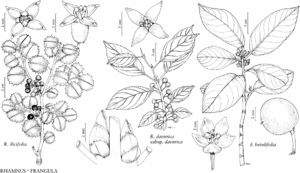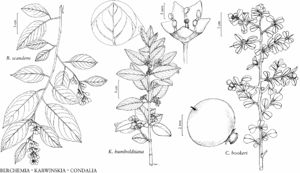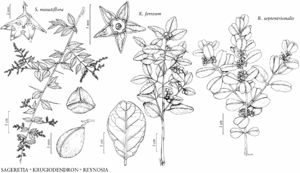Difference between revisions of "Rhamnaceae"
FNA>Volume Importer |
imported>Volume Importer |
||
| Line 231: | Line 231: | ||
|publication year= | |publication year= | ||
|special status= | |special status= | ||
| − | |source xml=https:// | + | |source xml=https://bibilujan@bitbucket.org/aafc-mbb/fna-data-curation.git/src/bb6b7e3a7de7d3b7888a1ad48c7fd8f5c722d8d6/coarse_grained_fna_xml/V12/V12_210.xml |
}}<!-- | }}<!-- | ||
-->[[Category:Treatment]] | -->[[Category:Treatment]] | ||
Revision as of 20:07, 27 May 2020
Shrubs, trees, or woody vines, [herbs, annual or perennial], evergreen or deciduous, synoecious, dioecious, or polygamous [monoecious], sometimes armed with thorns or stipular spines. Leaves alternate, fascicled, clustered, or opposite, simple; stipules present; petiole present (absent in Condalia); blade margins entire, serrate, serrulate, crenate, crenulate, dentate, or denticulate, sometimes spinose or spinulose; venation pinnate (sometimes obscurely, appearing 1-veined) or 3[–5]-veined from base (acrodromous). Inflorescences bisexual or unisexual, axillary or terminal, fascicles, umbels, panicles, cymes, or thyrses (these sometimes spikelike, racemelike, or paniclelike), or flowers solitary. Flowers bisexual or unisexual; perianth and androecium epigynous or perigynous [hypogynous]; hypanthium free or adnate to ovary proximally and free distally [absent]; sepals [3–]4–5(–8), distinct, valvate; petals 0 or [3–]4–5(–8), distinct; nectary present, intrastaminal, sometimes lining hypanthium; stamens [3–]4–5(–8), opposite petals, distinct, adnate to petal bases; anthers dehiscing by longitudinal slits; pistil 1, 2–4-carpellate, ovary superior to inferior, (1–)2–4-locular, placentation basal; ovules 1 per locule (2 per locule in Karwinskia), anatropous; styles 1–4, connate proximally to completely; stigmas 1–4. Fruits capsules, dehiscence loculicidal, schizocarps, samaras, or drupes. Seeds 1 (sometimes 2 in Karwinskia) per locule.
Distribution
North America, Mexico, West Indies, Central America, South America, Europe, Asia, Africa, Atlantic Islands, Indian Ocean Islands, Pacific Islands, Australia, mainly subtropical to tropical areas.
Discussion
Genera 50–52, species 900–950 (15 genera, 105 species in the flora).
The fused, cuplike basal portion of the flower has been variously called a hypanthium (as here), floral cup, floral tube, and calyx tube.
The bark, leaves, and fruits of Frangula alnus, F. purshiana, and Rhamnus cathartica have been used as laxatives. Old World species of Rhamnus provide yellow and green dyes as well as drugs. Wood of some species (in Alphitonia Reissek ex Endlicher, Colubrina, Hovenia, and Ziziphus) is used for construction, high quality furniture, carving, lathe work, and musical instruments. Ziziphus mauritiana (Indian jujube) and Z. jujuba (common jujube) are commercially cultivated for edible fruit. Hovenia dulcis is grown for its edible, fleshy inflorescence stalks. Some species of Ceanothus, Hovenia, Paliurus, and Rhamnus are cultivated as ornamentals.
Selected References
Lower Taxa
Illustrations
Key
| 1 | Woody vines. | > 2 |
| 2 | Tendrils present; fruits schizocarps; ovaries inferior. | Gouania |
| 2 | Tendrils absent; fruits drupes; ovaries superior. | > 3 |
| 3 | Stems twining, glabrous; leaf blade secondary, and usually tertiary, veins strongly parallel. | Berchemia |
| 3 | Stems not twining, hairy; leaf blade secondary veins not strongly parallel, tertiary veins reticulate. | Sageretia |
| 1 | Shrubs (sometimes clambering) or trees. | > 4 |
| 4 | Sepals usually incurved, sometimes becoming spreading, sepals and petals white, cream, blue, purple, or rarely pink; hypanthium less than 0.5 mm wide. | Ceanothus |
| 4 | Sepals spreading or erect, usually yellowish, yellowish green, green, or greenish white to white, sometimes brown, orange or purple; petals white, cream, yellow, yellow-green, or greenish, or 0; hypanthium 1–4 mm wide. | > 5 |
| 5 | Leaf blades 3-veined from near base (venation acrodromous). | > 6 |
| 6 | Inflorescences compound dichasia, appearing repeatedly dichotomously branched; peduncles and pedicels fleshy in fruit. | Hovenia |
| 6 | Inflorescences fascicles, cymes, or thyrses, or flowers solitary; peduncles and pedicels not fleshy in fruit. | > 7 |
| 7 | Plants unarmed; fruits capsules. | Colubrina |
| 7 | Plants armed with stipular spines; fruits drupes or samaras. | > 8 |
| 8 | Fruits samaras; leaf blade secondary veins distal to basal veins well developed; ovary 1/2-inferior; bud scales present. | Paliurus |
| 8 | Fruits drupes; leaf blade secondary veins absent or poorly developed distal to basal veins, except sometimes near apex; ovary superior; bud scales absent. | Ziziphus |
| 5 | Leaf blades pinnately veined, sometimes basal pair of secondary veins more prominent or blade obscurely veined, appearing 1-veined or vaguely 3-veined from base. | > 9 |
| 9 | Leaves alternate, sometimes fascicled or clustered terminally. | > 10 |
| 10 | Fruits capsules, sometimes tardily dehiscent; ovaries 1/2-inferior. | Colubrina |
| 10 | Fruits drupes; ovaries superior. | > 11 |
| 11 | Inflorescences axillary or terminal, spikelike or spicate, paniclelike thyrses, overtopping or extending beyond foliage. | Sageretia |
| 11 | Inflorescences axillary, fascicles, umbels, cymes or thyrses, or flowers solitary, within foliage. | > 12 |
| 12 | Drupes with 2–4 stones. | > 13 |
| 13 | Leaf blade secondary veins arching, not parallel; bud scales present, buds glabrate; flowers usually unisexual, rarely some bisexual (plants polygamous); sepals thin, spreading, not keeled adaxially; petals 0 or 4, not clawed; styles 2–4, connate proximally; hypanthia usually not circumscissile, rarely so at or just proximal to sepal bases; stones longitudinally dehiscent; seeds not beaked, longitudinally furrowed. | Rhamnus |
| 13 | Leaf blade secondary veins nearly straight, parallel; bud scales absent, buds hairy; flowers bisexual; sepals fleshy, usually ± erect, sometimes spreading, keeled adaxially; petals (rarely 4–)5, clawed; styles 1; hypanthia usually circumscissile far below sepal bases, rarely not circumscissile; stones indehiscent but open at base; seeds with cartilaginous beak, not furrowed. | Frangula |
| 12 | Drupes with 1 stone. | > 14 |
| 14 | Leaves not borne on short shoots; plants unarmed; sepals crested adaxially. | Krugiodendron |
| 14 | Leaves mostly borne on short shoots, if not, then plants armed with thorns; sepals keeled adaxially. | > 15 |
| 15 | Petals 0 (5 in C. ericoides, with linear, revolute leaves); nectaries absent, thin, or margins thickened, lining hypanthium; styles 1. | Condalia |
| 15 | Petals 5; nectaries fleshy, filling hypanthium; styles 2(–4). | Ziziphus |
| 9 | Leaves opposite or subopposite. | > 16 |
| 16 | Plants armed with thorns. | > 17 |
| 17 | Leaves early deciduous, usually absent by flowering; fruits capsules. | Adolphia |
| 17 | Leaves persistent or deciduous, present at flowering; fruits drupes. | > 18 |
| 18 | Inflorescences fascicles or flowers solitary, within foliage; sepals 4, not keeled adaxially; petals 0 or 4; trees or shrubs, erect or spreading. | Rhamnus |
| 18 | Inflorescences spikelike or spicate paniclelike thyrses, overtopping or extending beyond foliage; sepals 5, keeled adaxially; petals 5; shrubs arching, sprawling, drooping, or clambering. | Sageretia |
| 16 | Plants unarmed. | > 19 |
| 19 | Leaves deciduous; petals 4–5. | > 20 |
| 20 | Leaf blades not gland-dotted abaxially, secondary veins arching; petals 4; ovules 1 per locule; drupe stones 2–4, dehiscent. | Rhamnus |
| 20 | Leaf blades gland-dotted abaxially (secondary veins appearing light- and dark-banded), secondary veins relatively straight; petals 5; ovules 2 per locule; drupe stones 1, indehiscent. | Karwinskia |
| 19 | Leaves persistent; petals 0. | > 21 |
| 21 | Leaf blade secondary veins arching near margins, higher order veins not forming adaxially raised reticulum; sepals crested adaxially; drupes 5–8 mm. | Krugiodendron |
| 21 | Leaf blade secondary veins straight nearly to margins, higher order veins forming adaxially raised reticulum enclosing isodiametric areoles; sepals small-keeled, not crested, adaxially; drupes 10–20 mm. | Reynosia |


